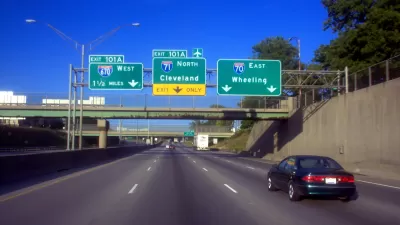When it comes to infrastructure, we are frequently reminded of the consequences of not repairing roads and bridges. Two prolific transportation writers recently changed the focus to where the money is spent.
Eric Jaffe of CityLab and Angie Schmitt of Streetsblog USA analyze Smart Growth America (SGA)'s "Repair Priorities 2014" report for their respective publications. The report itself is an update of SGA's 2011 report.
"The numbers tell the story best," writes Jaffe. "From 2004 to 2008, states dedicated just 43 percent of their road budgets to maintain existing roads despite the fact that they made up nearly 99 percent of the road system. The other 1 percent—new construction—got more than half the money."
From 2009 to 2011 states did only marginally better, spending 55 percent of their road money ($20.4 billion) on expansion and just 45 percent on maintenance ($16.5 billion).
However, sometimes new, costly construction over less expensive maintenance is justified, particularly when it comes to replacing structurally deficient bridges. Case in point, "the decaying Frederick Douglass Memorial Bridge, a mere 'dozen blocks from the dome of the U.S. Capitol'," as noted here recently. "[The occasional] falling concrete from the bridge poses a threat only to the fish in the Anacostia River below."
The bridge is also the first of "seven big infrastructure projects that are on the verge of collapse" described in the Vice Magazine article referenced Schmitt as an introduction to her insightful piece.
It's not as if the bridge hasn't been maintained. "In 2007, the bridge was closed from July 6 to August 29 for a $27 million renovation project meant to extend its life for 20 years," according to Wikipedia. Ashley Halsey III wrote in Dec. 2012 that it "needs to be replaced, at a cost of almost $661 million in a project with an overall price tag of $906 million." However, going from four to six lanes, as the plan notes, seems like it will only invite more driving as well as additional expense. But bike critics might say the same thing about the improvement to bike and pedestrian facilities.
Streetsblog USA's Angie Schmitt sees the problem of new construction vs. maintenance as symptomatic of a greater problem. "The system is set up to funnel the vast majority of spending through state departments of transportation, and those agencies have an absolutely terrible track record when it comes to making smart long-term decisions," she writes. "As long as state DOTs retain unfettered control of the money, potholed roads and decrepit bridges will remain the norm."
This is not a new theme for Schmitt. In 2011, she questioned the purpose of increasing Missouri's gas tax if it was only going to finance the I-70 expansion and other expensive, highway-widening projects, as we noted here.
FULL STORY: America's Infrastructure Crisis Is Really a Maintenance Crisis

Pennsylvania Mall Conversion Bill Passes House
If passed, the bill would promote the adaptive reuse of defunct commercial buildings.

Planning for Accessibility: Proximity is More Important than Mobility
Accessibility-based planning minimizes the distance that people must travel to reach desired services and activities. Measured this way, increased density can provide more total benefits than increased speeds.

World's Largest Wildlife Overpass In the Works in Los Angeles County
Caltrans will soon close half of the 101 Freeway in order to continue construction of the Wallis Annenberg Wildlife Crossing near Agoura Hills in Los Angeles County.

Alaska Village Becomes Test Case for Climate Change Relocation
The Yup’ik village of Newtok is the first Alaska community to begin a full-scale relocation necessitated by the impacts of climate change. Another 31 Alaska communities remain vulnerable.

Amtrak Takes Lead on Texas Central Rail
The high-speed rail project isn’t a done deal, but if it moves forward, trains could begin operating in 2030.

Maine Approves Rent Relief Program
Legislators hope the assistance program will help struggling low-income households avoid eviction.
City of Costa Mesa
Licking County
Barrett Planning Group LLC
HUD's Office of Policy Development and Research
Mpact Transit + Community
HUD's Office of Policy Development and Research
Tufts University, Department of Urban and Environmental Policy & Planning
City of Universal City TX
ULI Northwest Arkansas
Urban Design for Planners 1: Software Tools
This six-course series explores essential urban design concepts using open source software and equips planners with the tools they need to participate fully in the urban design process.
Planning for Universal Design
Learn the tools for implementing Universal Design in planning regulations.


























